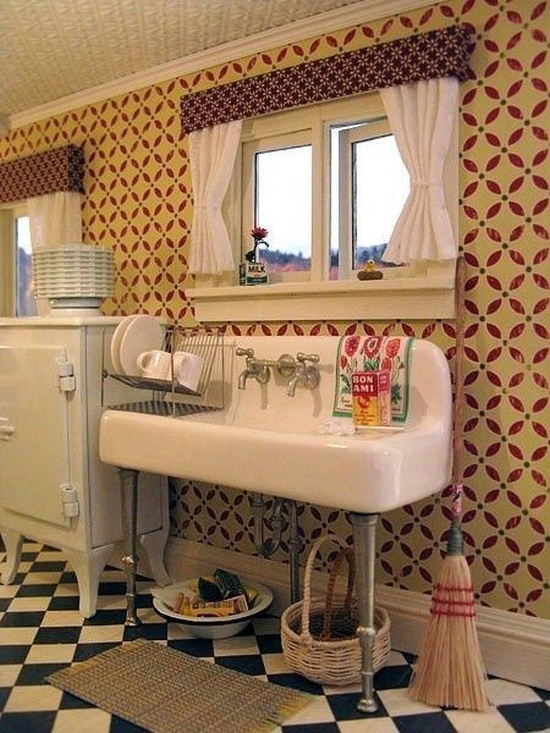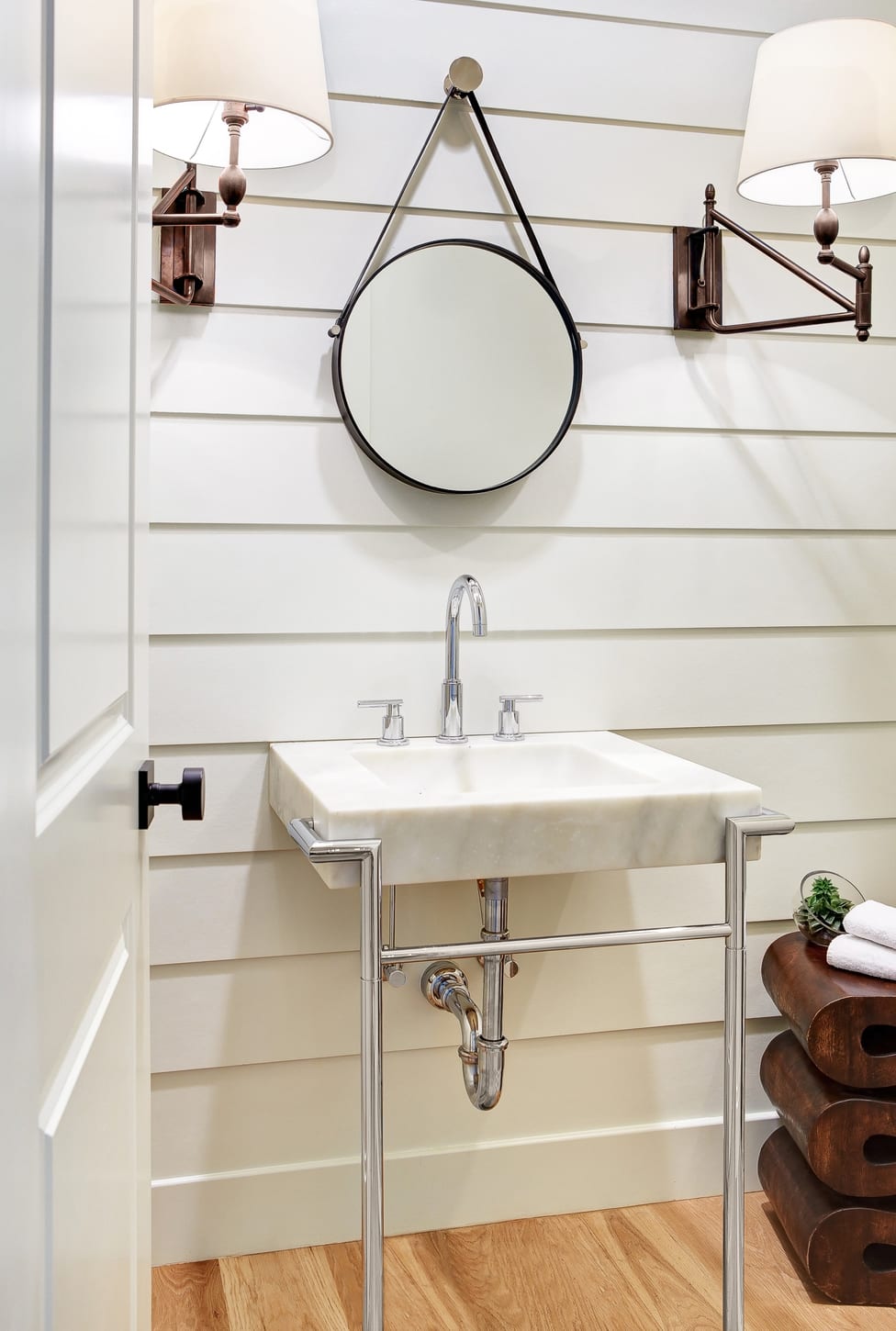Everybody has a sink or two in the bathroom, and a cabinet or a base for it is essential: first, it hides the ugly sink legs, and second, it can serve for storage. You may take a basic cabinet and turn it into a sink base changing the size, doors, colors and patterns. Add a couple of shelves inside and maybe on the doors for storage. You can makeover an existing one, change the colors and patterns, stenciling it and changing the legs and handles. Building your own cabinet isn’t difficult, just grab some wood and have a look at the plans to make it. Read the tutorials below and choose the best idea!
Each tee is about 2.5 inches, so the total height of the sink legs ended up being 32 inches. The crossbeam lengths will be determined by the underside of your sink basin. For my sink, I used 1/2 pipe, which is plenty sturdy. Assembling the pieces is a bit of a puzzle. My recommendation – put the legs together first. Flexible tubing is the best option for a console sink. Place some Teflon tape on the threads of the pipe and connect the flexible line. Tighten the nut with an adjustable wrench. Do the same to the other pipe. Connect the hot water line to the sink and tighten the compression nut. Follow the same procedure with the cold water line. Aug 25, 2016 - Explore Sallie Webb's board 'console sink' on Pinterest. See more ideas about Console sink, Bathroom design, Bathrooms remodel.
DIY board bathroom cabinet (via martysmusings)
DIY wooden vanity (via thespacebetweenblog)

DIY butcher block vanity (via beneathmyheart)
DIY Napoleon sink console (via ana-white)

DIY sink cabinet makeover (via inmyownstyle)
DIY bathroom cabinet repaint (via myclevernest)

DIY vanity sink cabinet (via ana-white)
DIY vanity sink base (via thequaintcottage)
DIY sink base of a regular cabinet (via diydiva)
Diy Console Sink Legs Sink
DIY sink console (via ninahendrick)
Console Sinks For Sale
DIY sink base to build (via grandmashousediy)
(I know, it sounds daunting, but I promise, you can do this!)
The one bathroom in my house is very small – 5 feet by 8 feet small. The previous owners had put in a small vanity and sink to allow for more storage. But the bulky thing took up way too much space and made the bathroom seem even more cramped. I knew the bathroom needed to be updated, and I needed a smaller sink.
I looked at pedestal sinks first. While they are much more compact, they do not afford for any storage space. While wandering a couple of local bathroom showrooms, I discovered console sinks. While the footprint is a bit larger than a pedestal sink, the open legs make it feel more open, and many have an open shelf underneath that allows for storage. Of course, I was finding that console sinks are a little pricey. And, as often happens, I found myself thinking, “I could make that!” And so I did!
Finding the perfect sink basin
I love used building supply stores. In Seattle, we’re lucky enough to have a few of them. Among all the cool old light fixtures and vintage décor, there always seem to be a large number of sinks and bathroom supplies there. I knew I needed just the basin, and that it needed to have a flat bottom. I also measured the area I wanted to install it in so I knew the widest the sink could be.
I hit the jackpot at my favorite second-hand building store – Earthwise in South Seattle. There was a beautiful sink basin that was missing it’s pedestal, and so was on sale for $35. Flat bottom, perfect size, I was in love!
Don’t lose heart if you don’t have a second-hand building supply store nearby; you can find sink basins at hardware stores like Lowes or Home Depot.
Building the console legs
I’m finding that I am a bit obsessed with galvanized pipe. I love the rustic touch it gives, whether building shelf supports, or lamps, or in this case, sink legs.

Before you head to the hardware store, determine how you want to set up the console. For mine, I knew I wanted rails across the top in the front and back to hang a towel from. And I knew on the sides, I’d want braces to set a shelf on. The picture on the left is actually my sink, mid-build and upside down. Draw yourself a quick sketch, with approximate measurements and then head off to the store.
When you’re selecting your pipes, make sure that you account for the connector pieces. In my case, I wanted a tall sink. Each leg (from the bottom-up) has an 8-inch nipple (yes, smaller pipe lengths are called nipples! Stop your giggling!), stacked with a tee, then a 12-inch, then another tee at the same angle, followed by a 4-inch, another tee perpendicular to the last, followed by a 3-inch nipple. Each tee is about 2.5 inches, so the total height of the sink legs ended up being 32 inches. The crossbeam lengths will be determined by the underside of your sink basin. For my sink, I used 1/2 pipe, which is plenty sturdy.
Assembling the pieces is a bit of a puzzle. My recommendation – put the legs together first. Then, put together the two sides. Finish with the front and back cross pieces. Wherever you can, use the pipes themselves to provide the wrenching power to tighten the pipes as much as you can. Make sure to lay the legs side-by-side and measure the distance between the pipes and the connectors to ensure that each section is exactly the same length – tighten more if one is a bit too long. The last couple of pipes may be tough – you’ll need to tighten on one side, then line up with the connector and actually unscrew it from the one side in order to screw it in on the other side. Try to match which pipes you do this with – if it’s the bottom one on one side, do the same with the bottom one on the other side.
Painting the legs
First make sure that you’ve thoroughly cleaned the pipes. They will be dirty, and may have stickers on them. Use GooGone, or rubbing alcohol to remove the stickers and clean the residue. You may choose to keep the pipes their galvanized color. I love that raw look! For my bathroom though, all my fixtures were oil-rubbed bronze. I chose to paint my sink legs the same color.
You can absolutely buy spray primer and spray paint to paint your sink legs. That’s what I did. If you go that option (which is super affordable!), do note that this paint is susceptible to scratches, so you may need to touch up later. Another option is to take it to an auto-body shop or other industrial paint shop and have them powder coat it. This is by far the more durable option, and you would have a great variety of colors and finishes.
Assembling the sink
I had the legs built, but knew that I didn’t want the bare metal ends to scratch the sink, or my floors. Perfect solution – rubber chair leg caps! They come in 1/2-inch, which fit perfectly!
In the bathroom, I set the legs where they needed to be, and placed the sink on top of them. I made sure everything was even and level. The weight of the sink keeps the legs in place – no need to secure them.
You will, however, need to secure the sink. Your sink should have holes underneath that allow you to screw the basin to the wall. I was lucky in that I had studs in the wall exactly where the the holes were. However, if you do not, you may need to put in drywall anchors to screw into to support the weight of the sink. Set the screws, and your sink is in place!
In a future post, I will show you how to install a faucet and drain. For now, here is the final product!
